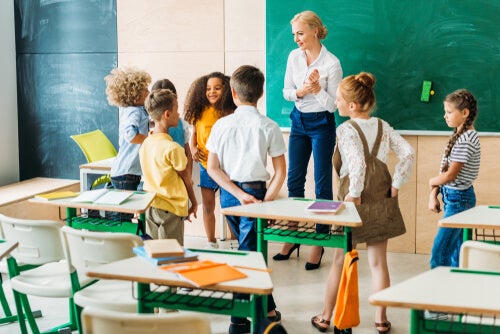Flipped Classroom - What Exactly Is It?

A flipped classroom is a pedagogical model that transfers the work of certain learning processes outside a classroom. Meanwhile, teachers use actual classroom time to work on the issues the students need help with.
The students prepare the lessons outside of class. They do so by accessing the contents of the subjects at home. Then, they do the “homework” when they’re back in the classroom, along with participatory activities. In addition, they analyze the ideas and debate with their peers. This is all based on new technologies. Therefore, the teacher is mainly a guide.

Origin of the flipped classroom
Jonathan Bergmann and Aaron Sams, two chemistry professors at Woodland Park High School in Colorado, coined the term “flipped classroom”. Bergmann and Sams noticed how students frequently missed some of their classes for various reasons. For example, because they were sick.
In an effort to help them, they began to encourage the recording and distribution of videos. In addition, they realized this model allows the teacher to pay more attention to each student’s individual needs.
“Many struggling students who genuinely want to learn fall behind instead. Others are so busy that they miss out on key concepts. Still others learn how to “play school,” but never really learn important objectives in their courses.”
-Aaron Sams-
An alternative to the traditional classroom methodology
The main advantage of a flipped classroom is that the teacher can adapt to the different learning rhythms. Also, none of the students stay behind.
The teacher transmits information that’s easy for some to process but not for others in a traditional classroom. However, there are advantages and disadvantages to doing homework at home. Unfortunately, only those whose parents are knowledgeable enough to explain topics they don’t understand are always ahead. As you can see, this innovative method allows every student to get just what they need in class.
The educational innovation of this pedagogical model offers many benefits to education regarding the teaching/learning process. All the students are the protagonists of this model. They do participatory activities in dynamic and interactive learning sessions while the teacher is just a helpful observer.
As you can see, teachers can spend more time giving individualized attention to students. This creates a collaborative learning environment in the classroom. Thus, the entire educational community (family, teachers, social community, and teachers, among others.) becomes a participant in this learning process.
This is truly great because it allows students to access the knowledge they build and expand it according to what they want. Likewise, it also facilitates the possibility for students to access the content they all generated and/or the one provided by their teachers at any time.
ICT to boost flipped classroom
New technologies drive new learning models and much more interactive classes. The flipped classroom allows the proper use of information and communications technology (ICT) in the classroom from an educational point of view. It’s not so much about the number of technological resources. Instead, their use is optimized so that students can create and share content.
In addition, ICT, along with this innovative methodology, provides a wonderful possibility: to create and share the teaching/learning process with students and teachers from anywhere in the world. It makes it even more enriching and quite a step away from traditional teaching methods.

Models that are similar to the flipped classroom
There are many out there, all developed under other denominations. For example, Peer Instruction (PI) was created by Eric Mazur, a Harvard professor. It incorporates a technique called just-in-time teaching that’s a great complement to the flipped classroom model.
Just-in-time teaching allows the teacher to receive feedback from students the day before class. This way, they can prepare strategies and activities to explain any topics the students might not understand.
Mazur’s model is largely focused on conceptual understanding. And although this element isn’t a necessary component of the flipped classroom, the two models are pretty similar in “spirit”.
This text is provided for informational purposes only and does not replace consultation with a professional. If in doubt, consult your specialist.








